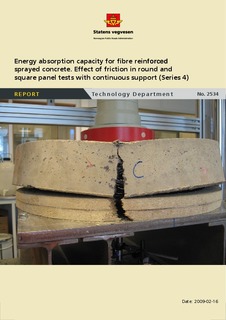| dc.description.abstract | The present test program is carried out as a part of the on-going revision of the Norwegian Concrete Association's publication no. 7 (Sprayed concrete for rock support), which, among others, is to be harmonized with the new European standards dealing with energy absorption capacity for fibre reinforced sprayed concrete. The new European standards describe square panels (continuous support), while the Norwegian tradition has been to test round panels (also continuous support) as described in the previous version of NB7. The program that has been undertaken is a comparative study of these two methods. The present report gives the results from the fourth test series in this program and is focused on the effect of friction during such tests. The used concrete mix has a nominal water-to-binder ratio of 0.42 and has a 20 kg/m3 dosage of 35 mm long steel fibres with end-hooks. All specimens were ready-mixed and cast in-situ (not sprayed). The 28-days compressive strength of the concrete was 72 MPa. The potential effect of friction is the same for round and square panels, presuming that the support material is the same. It is assumed that four perpendicular cracks form and that the cracks are oriented normal to the support. A theoretical evaluation reveals that the effect of friction will be somewhat less for square panels if the cracks are oriented closer to the corners. The energy absorption capacity (EAC) test results show that the average coefficient of variation (COV) was 7.8 % for the two individual sets with round panels and, similarly, 11.7 % for the square panels. The average COV for EAC for the two different friction conditions were quite similar. The EAC from square and round panels at similar support (friction) conditions corresponded well. In panel tests with continuous support the friction occurs in two directions; tangential and radial. The tangential- and radial movements of the panel relative to the support have been quantified. The results show that the friction conditions between the concrete panel and the support fixture has a great impact on the measured energy uptake. For the case denoted ''standard'' conditions, which is the normal set-up for panel tests, the results show that 35% of the overall energy uptake between zero and 25 mm deflection is due to friction, and the remaining 65% is due to fibre action in the concrete panel. When friction is eliminated in the test, the results show on average, that the maximum load during the test is reduced by 15 % and the residual load at 25 mm deflection is reduced by 46 %. By using the energy balance equations the coefficient of friction was deduced from the test results. It is found that the coefficient of friction is substantial and that it increases as the test proceeds. This may be associated with a gradual penetration of the sharp concrete crack edges into the wooden support. Adjustments of the early non-linear behaviour of the load deflection curves have been made in accordance to the procedure in ASTM 1550-05. The adjustments had no significant effect on the calculated energy absorption capacity. | nb_NO |
